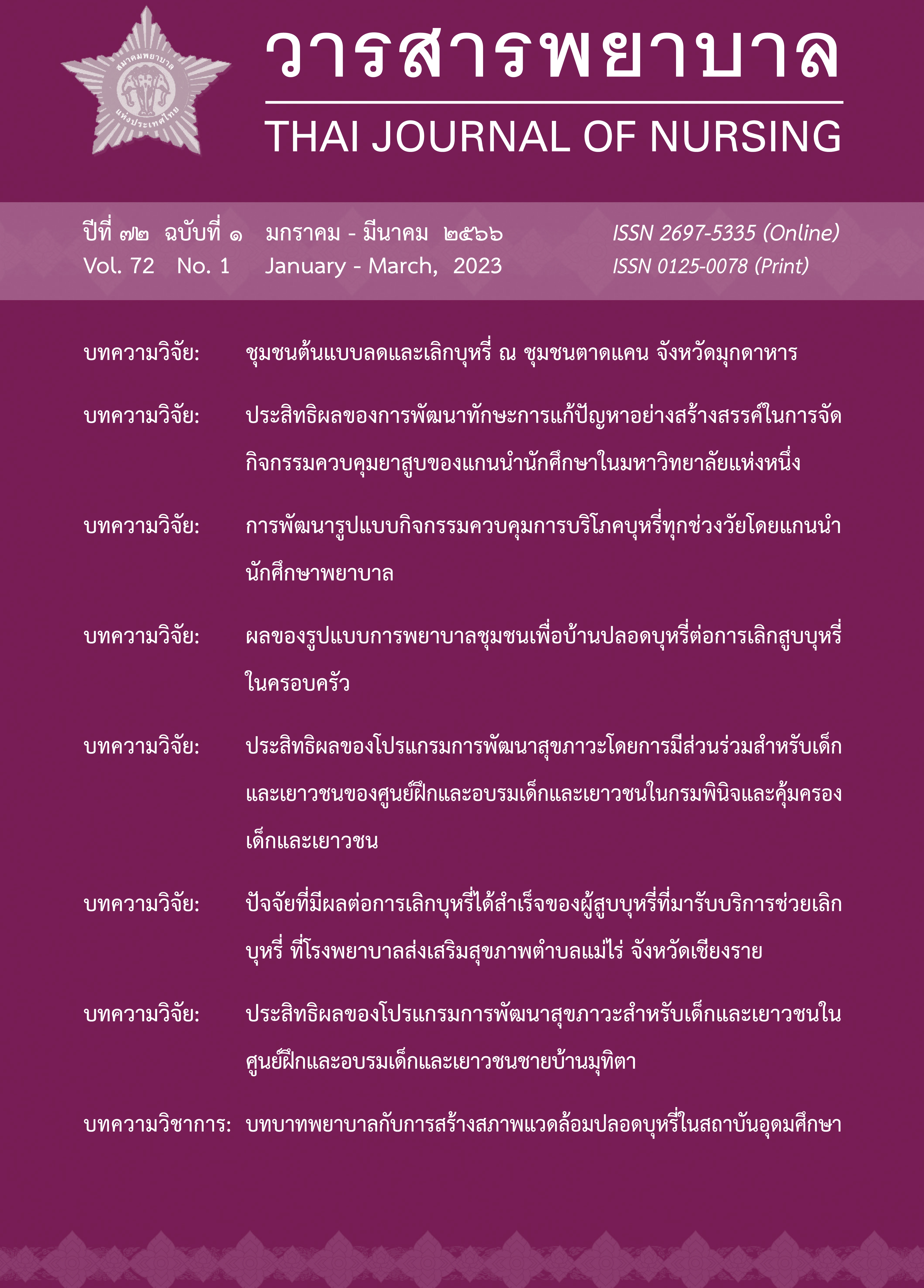The effect of a community nursing model for smoke-free home on quit smoking in family
Main Article Content
Abstract
This study aims to examine the effects of a community nursing model for smoke-free home on quit smoking in the pilot community at Thanyaburi District, Pathum Thani Province. The smoke-free home program comprises family assessment, family support with positive reinforcement to quit smoking, reminder of the no smoking rule, home environment improvement, brief advice for quit smoking by nurses, providing community support and monitoring, and referring to community hospital or quit line 1600. Data collection was performed using the nicotine dependence test, and piCO Smokerlyzer for exhaled carbonmanoxide measurement. Descriptive statistics, and repeated measures ANOVA were employed for data analysis. The smoker of 122, are males (88.5%) and females (11.5%) aged 18-83 years old (M = 44.15, SD = 16.56), mostly used factory cigarettes (83.6 %), following by hand-rolled cigarettes (13.4 %) and both types of cigarettes (3.3 %). The community nursing model for smoke-free home could help smokers continuously quit smoking for 6 months (12.3%), and represented smoke-free homes (77.05%). Mean difference test for nicotine addiction level before and after the program implementation at the 1st, 3rd, and 6th month reveal statistically significances at p < .01 (F = 21.663).
Article Details

This work is licensed under a Creative Commons Attribution-NonCommercial-NoDerivatives 4.0 International License.
References
กรมควบคุมโรค, กองงานคณะกรรมการควบคุมผลิตภัณฑ์ยาสูบ. (2565). แผนปฏิบัติการด้านการควบคุม ยาสูบแห่งชาติ ฉบับที่สาม พ.ศ.2565-2570 (ฉบับย่อ). อักษรกราฟฟิคแอนด์ดีไซน์.
กรองจิต วาทีสาธกกิจ. (2559). คู่มือการรักษาโรคเสพติดยาสูบสำหรับพยาบาล. มณปรียา กราฟฟิค.
พีรยา สุธีรางกูร, ทัศนีย์ รวิวรกุล, สุรินธร กลัมพากร, กัลยา ศารทูลทัต, พัชรินทร์ อัจนากิตติ, และฐาปนี ภานุภาส. (2565). การพัฒนารูปแบบการพยาบาลเพื่อบ้านปลอดบุหรี่โดยชุมชนมีส่วนร่วม ศึกษาในพื้นที่อำเภอธัญบุรี จังหวัดปทุมธานี. [รายงานการวิจัยไม่ได้ตีพิมพ์]. คณะพยาบาลศาสตร์ ,มหาวิทยาลัยอีสเทิร์นเอเชีย.
วัลลภ รัฐฉัตรานนท์. (2562). การหาขนาดตัวอย่างที่เหมาะสมสำหรับการวิจัย มายาคติในการใช้สูตรทาโรยามาเน และเครจซี-มอร์แกน. วารสารสหวิทยาการวิจัย: ฉบับบัณฑิตศึกษา, 8(2), 11-28.
อรสา พันธ์ภักดี. (2563). แนวปฏิบัติการพยาบาลเพื่อช่วยเลิกบุหรี่ คู่มือการให้คำแนะนำการช่วยเลิกสู่งานประจำ. สื่อตะวัน.
Aryal, U. R., Bhatta, D. N., Shrestha, N., & Gautam, A. (2015). Assessment of nicotine dependence among smokers in Nepal: A community based cross-sectional study. Tobacco Induced Diseases, 13(26), 1-8. https://doi: 10.1186/s12971-015-0053-8
Aurrekoetxea, J. J., Murcia, M., Rebagliato, M., Guxens, M., Fernandez-Somoano, A., Lopez, M. J. Lertxundi, A., Castilla, A. M., Espada, M., Tardon, A., Ballester, F., & Santa-Marina, L. (2016). Second-hand smoke exposure in 4-year-old children in Spain: Sources, associated factors and
urinary cotinine. Environmental Research, 145, 116-125. https://doi: 10.1016/j.envres.2015.11.028
Clough, A. R., Grant, K., Robertson, J., Wrigley, M., Nichols, N., & Fitzgibbon, T.]2018). Interventions to encourage smoke-free homes in remote indigenous Australian communities: A study protocol to evaluate the effects of a community-inspired awareness-raising and motivational enhancement strategy. British Medical Journals, 8(3), Article e018955. https://doi: 10.1136/bmjopen-2017-018955
David, A. M., Mercado, S. P., Klein, J. D., Kaundan, M. s. o. K., Koong, H. N., & Garcia, E. (2017).
Protecting children and families from tobacco and tobacco-related NCDs in the Western Pacific: Good practice examples from Malaysia, Philippines and Singapore. Child: Care, Health &
Development, 43(5), 774-778. https://doi: 10.1111/cch.12472
Esteves, E., Saona, G., Baldizzoni, M., Wald, I., & Rey, N. (2018). Predictive factors of 6 month continuous abstinence at the beginning of treatment. Tobacco Induced Diseases, 16(1), 880.
https://doi: 10.18332/tid/84514
Gallus, S., Lugo, A., Gorini, G., Colombo, P., Pacifici, R., & Fernandez, E. (2016). Voluntary home smoking ban: prevalence, trend and determinants in Italy. European Journal of Public Health, 26(5), 841-844. https://doi: 10.1093/eurpub/ckw146
Kleier, J. A., Mites-Campbell, M., & Henson-Evertz, K. (2017). Children’s exposure to secondhand smoke, parental nicotine dependence, and motivation to quit smoking. Pediatric Nursing, 43(1), 35-39.
Kuntz, B., & Lampert, T. (2016). Social disparities in parental smoking and young children's exposure to secondhand smoke at home: a time-trend analysis of repeated cross-sectional data from the German KiGGS study between 2003-2006 and 2009-2012. BMC Public Health, 16, 485. https://doi: 10.1186/s12889-016-3175-x
Maulana, M., Jatmika, S. E. D., Martini, S., Widiarti, S., & Azizah, S. N. (2020). Smoke-free home program with number of cigarettes in Yogyakarta. Advances in Health Sciences Research, 22, 398-402.
Merianos, A. L., Dixon, C. A., & Mahabee-Gittens, E. M. (2017). Secondhand smoke exposure, illness severity, and resource utilization in pediatric emergency department patients with respiratory illnesses. Journal of Asthma, 54(8), 798-806. https://doi:10.1080/02770903.2016.1265127
Muzammil, K., Singh, S., Singh, J., Sanjeev, D., Raghav, S., & Khalil, S. (2015). A cross-sectional study of tobacco addiction among college students of Muzaffarnagar city. Indian Journal of Community Health, 27, 125-128.
Ossip, D. J., Johnson, T., Assibey-Mensah, V., Wang, S., McLaren, D., Calabro, K., Prokhorov, A. V., & McIntosh, S. (2018). Smoke-free home and vehicle policies among community college smokers. Health Education & Behavior, 45(4), 540–549. https://doi.org/10.1177/1090198117742437
Owili, P. O., Muga, M. A., Pan, W. C., & Kuo, H. W. (2017). Indoor secondhand tobacco smoke and risk of under-five mortality in 23 sub-Saharan Africa countries: A population based study and meta- analysis. PLoS ONE, 12(5), 1-17. https://doi: 10.1371/journal.pone.0177271
Suteerangkul, P., Lagampan, S., Auemaneekul, N., & Kalampakorn, S. (2019). Thai community
perspectives on suburban smoke-free homes: qualitative findings from a mixed method study.
Pacific Rim International Journal of Nursing Research, 23(2), 106-117.
Uti, O., Sofola, O., Adeyemo, W., & Ogundana, O. (2018). Pattern of smoking and nicotine dependence in Lagos State Nigeria. Tobacco Induced Diseases, 16(1). 803. https://doi: 10.18332/tid/84644
Vijayaraghavan, M., Benmarhnia, T., Pierce, J. P., White, M. M., Kempster, J., Shi, Y., Trinidad, D. R., & Messer, K. (2018). Income disparities in smoking cessation and the diffusion of smoke-free homes among U.S. smokers: Results from two longitudinal surveys. PLOS ONE, 13(7), Article e0201467. https://doi: 10.1371/journal.pone.0201467
Xie, M., Jia, C., Zhang, Y., Wang, B., Qin, N., Cao, S., Zhao, L., Yu, D., & Duan, X. (2020). Household exposure to secondhand smoke among Chinese children: status, determinants, and co-exposures. International Journal of Environment Research and Public Health. 17(15). 1-12. https://doi: 10.3390/ijerph17155524


